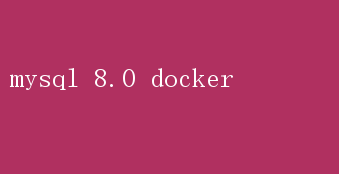如何在Docker中部署MySQL8.0数据库实战指南
资源类型:00-5.net 2025-07-29 08:52
mysql 8.0 docker简介:

MySQL8.0 on Docker: Revolutionizing Database Management in the Containerized Era In the rapidly evolving landscape of technology, containerization has emerged as a game-changer, transforming how applications are developed, deployed, and scaled. Among the myriad container platforms, Docker stands out for its simplicity, efficiency, and widespread adoption. When combined with MySQL8.0, the most advanced and feature-rich version of the popular relational database management system(RDBMS), the synergy unlocks unparalleled potential for modern data-driven applications. This article delves into the compelling reasons why deploying MySQL8.0 on Docker is a strategic decision for organizations seeking to optimize their database management practices. The Evolution of MySQL and the Rise of Containers MySQL, owned and maintained by Oracle Corporation, has been a cornerstone of database management since its inception in1995. Over the years, it has evolved from a simple, lightweight database solution to a robust, scalable, and highly available enterprise-grade RDBMS. MySQL8.0, released in April2018, introduced a plethora of innovations, including enhanced security features, improved performance, JSON table support, window functions, common table expressions(CTEs), and many more. Concurrently, the advent of containerization with Docker has revolutionized software development and deployment. By encapsulating applications and their dependencies within lightweight, portable containers, Docker enables seamless scalability, consistent environments across different stages of the development lifecycle, and easier orchestration through tools like Kubernetes. Why MySQL 8.0 on Docker? 1.Ease of Deployment and Scalability Deploying MySQL8.0 on Docker simplifies the provisioning process significantly. Instead of manually installing MySQL on each server, developers can pull a pre-configured Docker image from Docker Hub or create their own customized image. This approach reduces the complexity involved in setting up the database environment, ensuring consistency across different environments(development, testing, production). Moreover, Dockers containerization enables horizontal scaling. Adding more containers to handle increased load is straightforward, allowing for elastic scalability that aligns seamlessly with cloud-native applications. This is particularly beneficial for applications experiencing fluctuating workloads or requiring high availability. 2.Isolation and Security Containers provide a layer of isolation between applications, minimizing the risk of cross-contamination. When MySQL8.0 runs within a Docker container, it operates in its dedicated namespace, separate from the host system and other containers. This isolation ensures that any vulnerabilities discovered in MySQL or other applications do not compromise the entire system. MySQL8.0 itself brings several security enhancements, such as enhanced password expiration policies, role-based access control(RBAC), and better encryption options. Combining these features with Dockers isolation capabilities fortifies the overall security posture of your database environment. 3.Consistency Across Environments One of the most significant challenges in software development is maintaining consistency across various environments. Docker containers ensure that the MySQL8.0 instance running in development has the exact same configuration as the one in production. This consistency eliminates it works on my machine issues, accelerates debugging, and facilitates smoother transitions from development to deployment. 4.Resource Management and Optimization Dockers containerization allows for granular control over resource allocation. Developers can specify CPU, memory, and storage limits for each MySQL container, ensuring optimal use of available resources. This is particularly critical in cloud environments where costs are directly tied to resource consumption. MySQL8.0 also includes performance improvements like persistent generated column caching, parallel query execution, and enhanced indexing capabilities. Running MySQL8.0 in Docker containers allows these optim